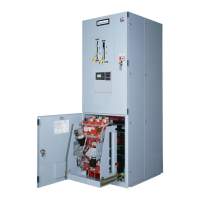O&M Manual –90E1720004
Section 9 Maintaining the Bypass-Isolation Transfer Switch Page 44 of 52
Section 9 Maintaining the Bypass-Isolation Transfer Switch
HAZARD OF ELECTRIC SHOCK, EXPLOSION, OR ARC FLASH
Inspect and perform preventative maintenance only on switches
and equipment to which power has been turned to the OFF
position, disconnected, and electrically isolated (unless otherwise
specified) so that no accidental contact can be made with
energized parts.
Follow safety related work practices as described in NFPA 70 –
Standard for Electrical Safety Requirements for Employee
Workplaces and ASHA Standards -29 CFR Part 1910 Subpart S –
Electrical.
Failure to follow these instructions will result in death or serious
injury.
Periodic maintenance on the transfer switch includes cleaning, lubrication, and exercising
component parts. The interval between maintenance checks can vary depending upon the
amount of usage and environmental conditions of each installation. The maximum
recommended inspection interval is one year. This definition for periodic maintenance applies
throughout this manual, unless otherwise noted.
Always inspect the switch after a fault.
Transfer Switch Inspection Guidelines
In general, the following guidelines may be followed. However, as conditions vary, the
maintenance program must also be adapted to provide a long life for the equipment and the
electrical system.
Periodic inspection of the equipment will be necessary to establish the conditions to which the
transfer switch is subjected (see “Ideal Operating Conditions” below, and “Normal Operating
Conditions” and “Harsh Operating Conditions”). Perform inspections and maintenance
according to these conditions. Inspect the equipment immediately after abnormal or stressful
operating conditions occur or after the equipment experiences a fault current.
These inspection and maintenance guidelines cover only Russelectric bypass-isolation transfer
switches. If conditions cannot be established and documented, then the harsh operating
condition must be assumed.
These inspection and maintenance guidelines do not warrant any field connections, field
modifications, or supersede any maintenance procedures or schedules recommended by
component manufacturers. For more information regarding the warranty of this product, refer to
“Russelectric Conditions of Sale.”
Ideal Operating Conditions
When the equipment is operating under the “ideal operating conditions” outlined below, it
should be able to operate without maintenance for a period of five years.
Environmental
Ambient room temperature range is 50 °F (10 °C) to 104 °F (40 °C).
Altitude is less than 6600 ft (2012 m).
Equipment is located indoors in a climate controlled room (heat/AC).

